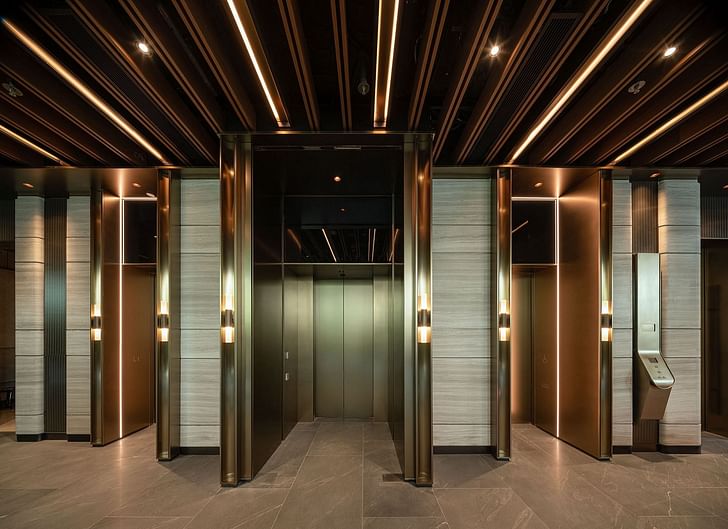

In many cases, your work sample is the first visual evidence you will offer a prospective employer when applying for a new architectural position. What you include in your sample, as well as how you structure and present it, is therefore important for creating a good first impression and increasing your chances of progressing through to an interview and job offer.
There is no one-size-fits-all approach to work samples, just as there is no one-size-fits-all approach to design. Your own work sample will be influenced not only by your preferences and tastes but also by the medium through which you are presenting it, the type of firm you are applying to, and the stage of your career.
The following set of ten tips on creating your work sample is, therefore, not a rigid prescription but answers to common queries we hear on the topic, suggestions based on the experience of our team and community, and questions to ask yourself as you assemble your own work sample to aid your next job search.
Do you have further advice for creating an architecture work sample while searching for your next role? Let us know in the comments.
In essence, your work sample is a visual snapshot of your architectural career. While your CV will contain the highlights of your architectural skills and experience in written form, your work sample translates these highlights into a visual format. The goal of your work sample is to present your strengths in a concise, visually appealing, and easy-to-digest format that gives a succinct introduction to your architectural capabilities, using a selection of your best work from practice and/or education.
In many cases, your work sample is the first visual evidence you will offer a prospective employer when applying for an architectural position. Employers will review your work sample alongside your cover letter and CV to help them decide whether to begin a conversation, such as inviting you to submit further work or attend an interview.
Think of your work sample as a way of getting your foot in the door of the interview room, in order to use your portfolio as the vehicle for the interview itself.
While a work sample and portfolio are both designed to showcase your skills and experience, crucial differences exist between the two. The most significant difference is in size. While a design portfolio can span many dozens of pages with complete accounts of several projects, a work sample may be as little as five or six pages in total. A work sample is, therefore, not intended to document a project from start to finish as a portfolio might but should instead capture the essence of a carefully curated selection of projects and how they embody your skills, experience, and approach.
A portfolio and work sample are also likely to feature at different stages of the job application process. Your work sample is frequently used in your initial application alongside your cover letter and CV, while your portfolio will play a more dominant role in later stages, such as an interview. Think of your work sample as a way of getting your foot in the door of the interview room in order to use your portfolio as the vehicle for the interview itself.

In a recent feature article on creating an elevator pitch for an architecture firm, we noted that one should develop several pitches to cater to a variety of audiences. The same applies to work samples. When applying to a particular firm, take time to research the practice and understand its design philosophy, values, and key projects.
Your research should begin on the firm’s website but may also include searching media outlets such as Archinect firm profiles to study where the practice has gained coverage and acclaim. Tailor your work sample document accordingly, prioritizing material that you feel will resonate with the firm.
If the firm you are applying to exhibits an interest in timber architecture, for example, seek to include projects and drawings that showcase your own experience with the material. If the firm specializes in construction stage work over concept design, emphasize construction-stage projects you have worked on in the past, or in the case of a recent graduate, technical drawings from your thesis project or building technology modules.
If you are in doubt, do not be afraid to call or email the firm to clarify.
When curating your work sample, pay close attention to the details of the job ad you are responding to. Given that your work sample is likely the first opportunity you have to showcase your abilities, the content of the work sample should align with the roles, responsibilities, capabilities, and experience requested in the job ad.
If the firm is seeking an individual with prior experience in retail projects, for example, your work sample should include high-quality material that either directly or tangentially relates to retail design. If the firm emphasizes a particular representational skill, such as physical modeling or photorealistic rendering, your work sample should similarly be tailored in response.
The job ad may also include specific information on how to apply, including the number of pages to be included in work samples or file size limits, all of which you should note and adhere to. Keep in mind that when a firm uses phrases in its job ad such as ‘sample portfolio’ or ‘mini portfolio,’ they are likely referring to what we are calling here a ‘work sample.’ If you are in doubt, do not be afraid to call or email the firm to clarify.

While aligning with the firm’s profile is important, the decision of what to include in your work sample should primarily be driven by quality. Your work sample should first and foremost include what you believe is your best material, ideally with a variety of media such as sketches, models, renders, 2D and 3D drawings, completion photographs, and, if appropriate, a variety of project typologies to demonstrate versatility. Avoid the mistake some make of ‘saving your best work for the interview.’
When showing material from your time at a previous firm, it is also likely that your best work was done as part of a team. Architecture is an inherently collaborative act, and you should not shy away from showing material with multiple authors in your work sample if the quality is high enough. In this case, state clearly and briefly what your role was in the material or project.
The quality of your supporting text also matters. Do not copy and paste descriptive paragraphs of text from your portfolio into your work sample. Instead, keep text descriptions short but clear, written in an engaging style that sets the scene for the visual material and evokes interest and curiosity in the viewer.
The more pages you add to your sample, or the more material you add to each page, the more you dilute the impact of each individual image.
As mentioned earlier, a work sample is not a portfolio. You do not need to narrate the full story of each project, and should instead focus on providing quality highlights to be unpacked and expanded upon in a portfolio interview. In many cases, a prospective employer will use your work sample not to meticulously study the details of each project but to gain a preliminary understanding of your background, skills, and experience. Narrating your ability is, therefore, more important than narrating the full story of a project.
Unlike in a portfolio interview, where you will likely find yourself measured against a handful of other candidates, your work sample will also be competing with dozens, perhaps hundreds of other applicants, meaning the person viewing your sample will not devote extensive time to unpacking your material. The more impactful your sample, the more it will stand out. Therefore, remember that the more pages you add to your sample or the more material you add to each page, the more you dilute the impact of each individual image.

As mentioned previously, a primary goal of your work sample is to make each individual element sing. In the literary world, writers will commonly employ the tactic of structural contrasts, alternating between long and short sentences in a paragraph to keep the reader engaged. The same goes for images. If your sample contains contrasts such as hand-drawn sketches versus photorealistic renders, or basic concept diagrams versus detailed construction drawings, a layout that alternates between these contrasts can heighten the impact of each image. This can work both between and within individual pages.
In addition, use white space effectively to create a clean, professional appearance. If your sample does benefit from having a page filled with many images and little empty space, consider bookending this page with less cluttered neighbors to offer breathing room for the material and reader.
Following these rules may not gain you any points, but failing to follow them will almost always lose you some.
While the material across your work sample may vary, it is advised that you still establish clear formatting rules. Without these, your sample may appear unprofessional or rushed in the eyes of the reader, regardless of the material quality. This includes consistent or proportional margin and spacing widths across pages, consistent rules on font types and sizes, consistent placement of labels, and flexible rules on page composition, such as the ratio of text to images, a family of height/width image ratios, and motifs for where images do and do not appear on pages.
While many of these rules are open for interpretation and adoption, some rules in your work sample are non-negotiable. Do not use low-resolution images, which will detract not only from themselves but the wider sample. Always perform a proofread and spellcheck on text. If you are attaching your work sample to an email or uploading it to a website, give it a clear and professional file name and study carefully how the material (particularly detailed drawings) appears on a computer screen versus being printed. Following these rules may not gain you any points, but failing to follow them will almost always lose you some.

As your career progresses, your work sample should evolve. As a recent graduate, your work sample will likely be heavily reliant on thesis projects, individual competitions, and extracurricular work. As you accumulate years in practice, however, the thesis material in your work sample should gradually be phased out in favor of more recent experience.
While the source of our material will evolve, so will our skills and interests. It is always worth returning to your work sample periodically to ask yourself if the material shown most accurately conveys your passion and abilities or the prevailing experience or capabilities sought after by employers.
The longer we spend laboring over our work sample, the more difficult it is to imagine the impact of the material on a first-time observer.
Given that your work sample is designed to be viewed by an external party, your network of architectural colleagues can become a valuable source of feedback on your material. In practice, this may include coworkers and industry acquaintances, while for recent graduates, you can approach classmates and professors.
The longer we spend laboring over our work sample, the more difficult it is to imagine the impact of the material on a first-time observer. Your network of peers, therefore, serves as a valuable proxy for potential employers.
Finally, follow our ongoing Archinect Tips series for advice and guidance on navigating your architectural career.
Niall Patrick Walsh is an architect and journalist, living in Belfast, Ireland. He writes feature articles for Archinect and leads the Archinect In-Depth series. He is also a licensed architect in the UK and Ireland, having previously worked at BDP, one of the largest design + ...
No Comments
Block this user
Are you sure you want to block this user and hide all related comments throughout the site?
Archinect
This is your first comment on Archinect. Your comment will be visible once approved.